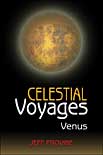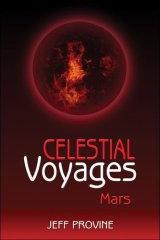
The Celestial Voyages Series
Celestial Voyages is a narrative taken from the journal of Curtis Matricks, a nineteen-year-old from Ohio in the dawn of the twentieth century. He is a down-to-earth rural physician's son, but he holds great interest and talent in astronomy. Through diligent studies in a rather peculiar hobby, he became familiar with the millions of tiny stars that lit up the clear night skies and the motions of the planets that orbit the Sun. After winning a worldwide contest in astronomical knowledge, Curtis receives an amazing offer: a position as Chief Astronomer in an expedition into Outer Space.

The Moon:
In the first book, we see through the eyes of Curtis Matricks the expedition of the famous Mason Star. The wealthy shipping magnate has spent years constructing a tower into the sky in what many see as a display of eccentricity. On January 1, 1900, Star reveals the true purpose of the tower: an orbital spaceport and dock for mankind's first spaceship, the Star's Comet. The expedition goes to the airless surface of the Moon, where excavations find a whole alien world hidden beneath the dusty surface.

Venus:
The second book continues as Mason Star hosts an exposition in London of amazing artifacts from the Moon. The display is plagued by Terrestrialists, humans who are wary of the dangers of interplanetary travel such as disease, potential strife, and general xenophobia and call for an end to Starís expeditions.
Star continues nonetheless to Venus, a world shrouded in thick veil of clouds. The expedition crash-lands into a world of dense, dark jungles where the explorers stumble upon another civilization, one where knowledge truly is power.

Mars:
The third book opens as Curtis Matricks makes a peculiar discovery while studying the orbit of the moons of Mars. An object mysteriously defies the laws of nature, changing position as if it were accelerating by its own power. Star launches his expedition to the desert world, finally fulfilling promises to figures such as Lord Kelvin and Nikola Tesla who aided him with technology necessary for interplanetary travel by giving them places among the crew. When they arrive at Mars, they find a world that has passed its prime, burgeoning with technology, but overpopulated and devoid of resources.
Historical Setting -
Celestial Voyages is reminiscent of other Victorian science fiction
adventures by authors such as Jules Verne and H. G. Wells. Unlike those writers
who were predicting the future, I have the opportunity of telling what might
have happened long ago. Armed with historical background, the story gains a
whole new level. There are several appearances by famous people of the day
including Queen Victoria, Samuel Clemens, President McKinley, and Thomas Edison,
as well as Verne and Wells themselves. Famous events of the day are also
mentioned such as the Boer War and the death of Queen Victoria.
 Clay Models of the Star's Comet
Clay Models of the Star's Comet

Technology -
Throughout the books, realistic "steam punk" technology is used wherever possible. Orbital elevators such as Star's Tower have long been applauded as a change from expensive rocket launches. Since there are no computers, the Starships are piloted by hand using a complex system of levers. Photosynthetic plants serve as air-purifiers and supply oxygen. Magnetic boots give a sense of artificial gravity. Rockets are powered by the same hydrogen-oxygen reactions that are used by space agencies today.
Aliens -
Here are a few sketches of the aliens created in the series, drawn in height comparison with a human. We have the insectoid Selenites, the plant-like Venusians, and the large-eyed "greys" of Mars.
Books are available at most book stores and online at sites such as Amazon, Borders, and Barnes & Noble.